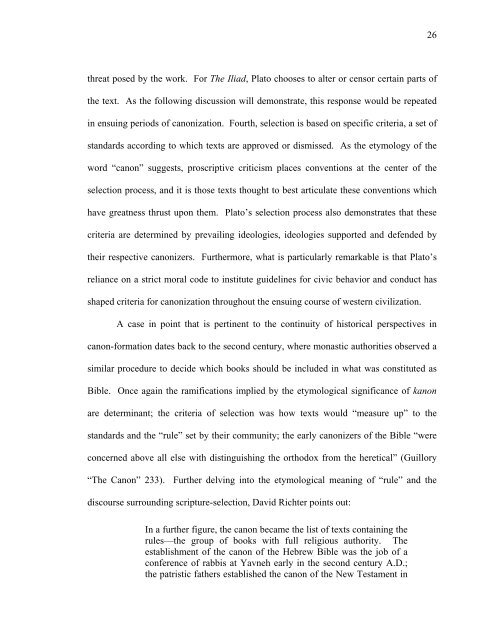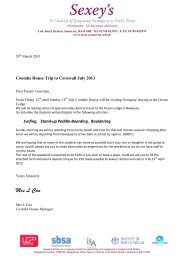Untitled - Sexey's School Moodle
Untitled - Sexey's School Moodle
Untitled - Sexey's School Moodle
Create successful ePaper yourself
Turn your PDF publications into a flip-book with our unique Google optimized e-Paper software.
threat posed by the work. For The Iliad, Plato chooses to alter or censor certain parts of<br />
the text. As the following discussion will demonstrate, this response would be repeated<br />
in ensuing periods of canonization. Fourth, selection is based on specific criteria, a set of<br />
standards according to which texts are approved or dismissed. As the etymology of the<br />
word “canon” suggests, proscriptive criticism places conventions at the center of the<br />
selection process, and it is those texts thought to best articulate these conventions which<br />
have greatness thrust upon them. Plato’s selection process also demonstrates that these<br />
criteria are determined by prevailing ideologies, ideologies supported and defended by<br />
their respective canonizers. Furthermore, what is particularly remarkable is that Plato’s<br />
reliance on a strict moral code to institute guidelines for civic behavior and conduct has<br />
shaped criteria for canonization throughout the ensuing course of western civilization.<br />
A case in point that is pertinent to the continuity of historical perspectives in<br />
canon-formation dates back to the second century, where monastic authorities observed a<br />
similar procedure to decide which books should be included in what was constituted as<br />
Bible. Once again the ramifications implied by the etymological significance of kanon<br />
are determinant; the criteria of selection was how texts would “measure up” to the<br />
standards and the “rule” set by their community; the early canonizers of the Bible “were<br />
concerned above all else with distinguishing the orthodox from the heretical” (Guillory<br />
“The Canon” 233). Further delving into the etymological meaning of “rule” and the<br />
discourse surrounding scripture-selection, David Richter points out:<br />
In a further figure, the canon became the list of texts containing the<br />
rules—the group of books with full religious authority. The<br />
establishment of the canon of the Hebrew Bible was the job of a<br />
conference of rabbis at Yavneh early in the second century A.D.;<br />
the patristic fathers established the canon of the New Testament in<br />
26



